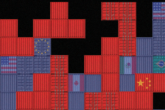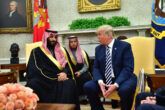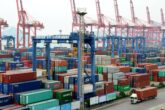December 07, 2021
Containing Crisis
Strategic Concepts for Coercive Economic Statecraft
Executive Summary
As the United States and China seek to manage an increasingly tense relationship, both sides have turned to coercive economic statecraft as a core part of their broader foreign policy, with disruptive impacts on the global economic order. A growing body of research examines the use of coercive economic tools, including prior work by the CNAS Energy, Economics, and Security program. This report adds to that literature by specifically examining the use of coercive economic tools during periods of geopolitical crisis to assess their value in de-escalating tensions or deterring further economic coercion. The researchers developed scenario exercises to examine these dynamics, supported by a literature review and extensive engagement with subject matter experts. The insights from the research informed the development of two overarching strategic concepts intended to guide U.S. policymakers when deploying economic tools as part of a crisis management situation.
Research Insights
From the scenario exercises and further research, the research team identified the following insights into how the United States and China may deploy coercive economic tools in times of crisis:
- China may be willing to deploy the widest range of economic tools in response to a geopolitical conflict.
- While both China and the United States may be willing to accept negative economic impacts to pursue geopolitical objectives, both also demonstrate a preference to broadly retain access to the other’s market, which may constrain the use of the most extreme forms of economic coercion.
- Countries other than the United States may be more reticent to take coercive economic actions against China due to fears of possible negative economic and political consequences.
- The United States may be advantaged by its alliances, and its ability to act jointly with allies may compensate for the narrower set of economic tools the United States is willing to use to manage geopolitical tensions.
- Persuasive rather than coercive tactics may best improve the United States’ negotiating position when it seeks to use economic statecraft to manage geopolitical tensions.
Strategic Concepts
Based on these insights, the research team recommends that the United States use the strategic concepts of joint pressure and bound engagement to guide its coercive economic statecraft policy.
The United States, coordinating with like-minded countries, should deploy joint pressure on China when using economic tools to respond to geopolitical escalation. Rather than acting alone, the United States should coordinate its responses with partner countries to maximize pressure on China, strengthen the ability of the United States to impose costs, and minimize China’s ability to retaliate. While certain circumstances may require the United States to act unilaterally or as a first mover, this should be a rare exception to the general posture of joint pressure.
The United States should have a strategy of bound engagement, by which it engages in economic escalation in a manner bound by constraints embodied in domestic and international rules and norms. This may include a domestic legal framework for use of economic tools, binding international trade and investment rules, or norms such as the concept of a proportionate response to a provocation. It may include rules by which both the United States and China are bound, such as World Trade Organization obligations, or rules that the United States develops with partners to guide joint coercive economic statecraft and to which China is not a party.
Introduction
The United States has long used its position as the leading military and economic global power to advance its vision of a liberal world order. However, the People’s Republic of China (PRC) has posed a formidable challenge to America’s leadership in recent years by offering an alternative model to existing international systems and norms developed and traditionally championed by the United States. As the Chinese Communist Party (CCP) consolidated its political power under Xi Jinping, clashes between the two systems over the future of economic and technological leadership have been increasingly fraught not only for U.S. national security but also that of U.S. allies.
To gain advantage in economic and technological competition, the United States and the PRC have traded blows in coercive economic measures, i.e., restrictions on trade, investment, and financial transactions intended to inflict costs on one another and induce policy change.1 As both countries possess significant leverage in market power, financial flows, and supply chains, they have employed measures that are increasingly cross-domain, combining the economic, financial, and diplomatic spheres. When these countries impose coercive measures against one another, other states may be impacted by a cycle of economic coercion and retaliation, which complicates the geoeconomic calculus of all actors. Firms may be forced to choose between investing in the Chinese market or investing elsewhere and building redundancy in supply chains. Overall, these and related factors contributed to reduced bilateral foreign direct investment in 2020.2
Amid the increasing number of coercive economic measures imposed in recent years, the 2020 “Phase One” trade deal between the United States and China attempted a brief respite from economic hostilities. It promised expanded Chinese purchases of U.S. goods and services to improve the U.S. trade balance with China and structural changes that would improve access for American firms that want to operate in the Chinese market. Nevertheless, China’s commitment to fully implement its obligations remains uncertain, and the United States and China likely will continue to utilize both threatened and actual coercive economic measures over time.3 Indeed, since the trade deal was signed in January 2020, there has been a series of coercive economic measures between the two countries. Significant actions include targeted multilateral sanctions in reaction to China’s treatment of the Uyghurs and significant Chinese counter sanctions, as well as the U.S. passage of the Hong Kong Autonomy Act and related sanctions in August 2020 in response to China’s imposition of the National Security Law in Hong Kong.4
The use of coercive economic statecraft likely will remain a constant factor in the bilateral relationship for the foreseeable future. Yet, the United States lacks a clear strategy for how and when to deploy coercive economic tools to successfully manage geopolitical crises. Existing literature has not yet defined overarching strategic concepts to guide policymakers in this realm. That is what this report seeks to accomplish. To examine how the United States and the PRC may deploy coercive economic measures against one another in times of geopolitical crisis, the CNAS research team integrated analysis from unique scenario exercises, structured interviews with subject matter experts, and a literature review. This report lays out the design and methodology of the scenario exercises, consolidates insights from the exercises and further research, and concludes with an exposition of strategic concepts and specific recommendations for how U.S. leaders can utilize economic tools to navigate geopolitical competition with the PRC.
Download the Full Report
- This definition of coercive economic measures is sourced from a previous CNAS report by Elizabeth Rosenberg, Peter Harrell, and Edoardo Saravalle, “China’s Use of Coercive Economic Measures,” CNAS, June 11, 2018, https://www.cnas.org/publications/reports/chinas-use-of-coercive-economic-measures. ↩
- Thilo Hanemann, Daniel H. Rosen, Mark Witzke, Steve Bennion, and Emma Smith, “Two-Way Street: 2021 Update, U.S.-China Direct Investment Trends,” Rhodium Group, May 19, 2021, https://rhg.com/wp-content/uploads/2021/05/RHG_TWS-2021_Executive-Summary_Final.pdf. There are other related policies and external factors that contributed to declining global foreign direct investment (FDI) in 2020. Global activity in FDI declined as a result of the COVID-19 pandemic. Moreover, there has been a general declining trend in U.S.-China foreign direct investment because of increased capital controls on China’s part, and as the PRC focused on clamping down on irrational spending (e.g., luxury real estate foreign direct investment). ↩
- “Remarks As Prepared for Delivery of Ambassador Katherine Tai Outlining the Biden-Harris Administration’s ‘New Approach to the U.S.-China Trade Relationship,’” Office of the U.S. Trade Representative, October 4, 2021, https://ustr.gov/about-us/policy-offices/press-office/press-releases/2021/october/remarks-prepared-delivery-ambassador-katherine-tai-outlining-biden-harris-administrations-new; Chad P. Bown, “The US-China Trade War and Phase One Agreement”, Peterson Institute for International Economics Working Paper No. 21-2, March 23, 2021, https://papers.ssrn.com/sol3/papers.cfm?abstract_id=3810026; and Chad P. Bown, “Why Biden Will Try to Enforce Trump’s Phase One Trade Deal with China,” Peterson Institute for International Economics, October 5, 2021, https://www.piie.com/blogs/trade-and-investment-policy-watch/why-biden-will-try-enforce-trumps-phase-one-trade-deal-china. ↩
- China imposed the National Security Law in Hong Kong in June 2020. “2021 Hong Kong Policy Act Report,” U.S. Department of State, March 31, 2021, https://www.state.gov/2021-hong-kong-policy-act-report/. The U.S. Department of Treasury imposed sanctions over the Chinese government entity Xinjiang Production and Construction Corps in July 2020. “Treasury Sanctions Chinese Entity and Officials Pursuant to Global Magnitsky Human Rights Executive Order,” U.S. Department of the Treasury—Office of Foreign Assets Control, July 31, 2020, https://home.treasury.gov/news/press-releases/sm1073. The Department of Treasury imposed sanctions over the Chinese government officials over undermining the autonomy and freedom of citizens of Hong Kong. “Treasury Sanctions Individuals for Undermining Hong Kong’s Autonomy,” U.S. Department of the Treasury, August 7, 2021, https://home.treasury.gov/news/press-releases/sm1088; Lauren Feiner and Amanda Macias, “Mnuchin Confirms TikTok is Under CFIUS Review Following National Security Concerns,” CNBC, July 29, 2020, https://www.cnbc.com/2020/07/29/mnuchin-confirms-tiktok-is-under-cfius-review.html. ↩
More from CNAS
-
Game Over?
The trade wargame suggests that sustained high tariffs could create leverage and urgency to spur action toward a productive restructuring of the international trade system....
By Emily Kilcrease & Geoffrey Gertz
-
Middle East Security / Energy, Economics & Security
Trump Inks $600 Bn Deal In Saudi Arabia | Musk, Blackrock CEO Flank Trump In Gulf VisitIn today's episode of India Global, U.S. President Donald Trump secured a $600 billion commitment from Saudi Arabia on Tuesday to invest in the United States. NDTV's Gaurie Dw...
By Daniel Silverberg
-
Energy, Economics & Security / Technology & National Security
Tariffs and Tech: An Uncertain RecipeHigher tariffs could prompt American cloud companies to shift more of their capital investments abroad....
By Pablo Chavez
-
Trump Tariffs: How Will U.S. Plans Reshape the Global Economy?
Donald Trump says he's already decided the tariffs he will impose on countries that export goods to America, including the United Kingdom. Channel 4 hears from Emily Kilcrease...
By Emily Kilcrease







